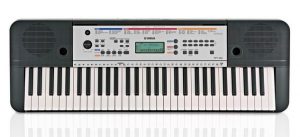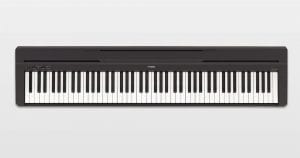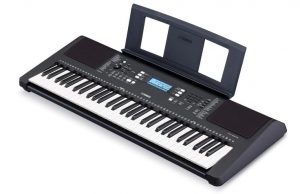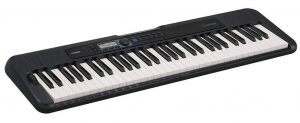Nothing can be soothing for the soul than music that comes from a grand acoustic piano. Many music enthusiasts learn the instrument out of their will and fulfill their desire to become trained musicians. But it is not possible for everyone to buy and play a grand acoustic piano, and this is where the digital pianos come to their rescue.
A digital piano is capable of replicating the music and the sound of an acoustic piano and it does it with the help of digital sampling technology. Digital pianos are also advantageous over acoustic pianos as it is possible to play and practice them with the help of headphones. These pianos do not require tuning and are much lighter and compact for learners to port them from home and their music classes.
Quick Summary: Best Learner Digital Pianos in 2024
Beginner Pianos vs Advanced Pianos
The 88 keys of a full-size piano keyboard cover seven octaves and three additional notes. Choose this if you want the most accurate piano experience. The next largest is acceptable if your options are limited by size (76 keys: six octaves, three notes). This will be helpful to you, but you will discover that you are reaching the lower limit on several classical songs, such as Beethoven’s “Für Elise,” and the upper limit on a lot of Chopin’s music (he adored the high notes).
Any fewer keys, and you’ll frequently reach the upper or lower limitations. Of course, if you don’t have the room and have to choose between 61 keys and nothing at all, 61 keys are the obvious choice. You will be constrained by five octaves, but that was all that was available in the 1700s as and for professionals.
The playing sensation of an acoustic piano is very successfully recreated by digital pianos, especially as technology advances. They offer the convenience and versatility of a keyboard. They are often composed of wood or an imitation substance with hammer action keys. They don’t need to be tuned or maintained physically in the same way as an acoustic piano, but this gives you the impression that you are playing a solid instrument. Similar to a digital keyboard, which provides a variety of piano and other instruments sounds, the sound is either manufactured or sampled. They feature all 88 keys, different from many digital keyboards, so you aren’t limited in what you can play. Although they come in a variety of sizes and shapes and are smaller than their acoustic counterparts, one drawback is that they are not very portable. As a result, if you choose one of these, you might need to explore where to put it in your house. Generally, digital pianos cost more than keyboards, but they are far less expensive than a comparable acoustic piano.
the unique tone and playing style that have influenced Western music for ages. You can feel the sounds resonating as you play, up through your fingertips and throughout the space. No electronics, sampling, or loudspeakers are used to produce this “acoustic” sound; just physical components are used.
The disadvantage of acoustic pianos is that they are by far the most expensive option, and the cost is not just for purchase. A piano costs money to move, and they require upkeep. Acoustic pianos require routine tuning since the parts react to even tiny changes in humidity or temperature. This implies that you should think about where to put an acoustic piano.
Should Beginner Pianos Have USB and MIDI Connections?
While MIDI compatibility is not a must for a music keyboard for beginners, it can become more significant to the student if they start playing electronic music or decide to connect the piano to a computer.
A MIDI to USB cable adapter may be required, depending on the type of your keyboard. To transport MIDI data, you can use either cable to link your keyboards to a computer, Android, or Apple device.
A USB MIDI connection (Musical Instrument Digital Interface), which enables you to connect a computer or portable device, is nearly always included on digital keyboards and digital pianos. This enables you to access more sounds, record your playing, and use other features of piano-learning software through apps and other programs.
Why Are Beginners’ Pianos Expensive?
Spending money on musical instruments is important. It is absurd to hinder your efforts with a subpar instrument if you are going to spend dozens of hours attempting to get the hang of it. You are lowering the value of your time and work by selecting a cheap instrument. A musical instrument can only be learned via consistent practice. Ineffective tools prevent that application. Without accommodating something unfit for the job, there is already much to learn and accomplish.
You are storing sound in your head when you play your instrument. Even if it seems obvious, you can’t see it, thus it isn’t. You are mentally connecting the sounds you are producing with your musical ideas. You want your on-stage musical voice to sound as much like your imagined one as feasible. The ideal is that. Is the student version of your instrument your voice? Most likely not. Beginners don’t remain novices for very long. Such choices should not be made based on inexperience. Invest the amount that makes reasonable sense to you generally.
How To Judge The “Build Quality” Of A Piano?
One of the best instruments for beginners is the piano. Most people use it as their first instrument and use it to continue learning more. In light of this, a novice should be introduced to digital pianos using a device that suits their requirements. Piano players who are experienced and improving their skill level require a piano that can develop along with them.
The adage “don’t judge a book by its cover” is one that we have all heard. Digital pianos can be compared in this way. Any digital piano has a difficult time competing with the authentically classic aesthetic of an acoustic piano. However, there are several types available in traditional hues and finishes that make it easier to ignore the artificial nature of it. Given this, it begs the question of how the remainder of the piano will perform if the business didn’t use high-quality materials in the display.
A high-quality piano must have weighted key action or graded hammer action. Avoid using piano keys that feel light and plastic-like. This is not to be confused with pianos that have plastic keys. Some offer various matte, ebony, or ivory coatings that significantly alter how the keys feel when pressed. A digital piano isn’t worth your money if, while playing it for yourself, you discover that the keys are slick or that the spaces are grabbing your nails. However, pay particular attention to how they react as you push the touch-sensitive keys. The keys should respond rapidly if you’re only softly pushing them. The keys should sustain appropriately if you’re playing a lengthy, challenging composition.
High-quality pianos may not provide a wide range of functions for beginners. They will have solid fundamental characteristics that a novice can learn to hone their hands and ears. Beginner digital pianos shouldn’t cost more than $500 for young children and $1,000 for adults. There are certain pianos that fall just outside of these price ranges, but for a beginner, there’s no need to invest more than this. Beginners should search for these characteristics in their potential digital piano while taking into account the sound quality and manufacturer.
Also Check out: Best Digital Pianos & Keyboards for Beginners
Top 4 Best Digital Pianos for Learning
We have described the best digital pianos for learning here and almost all of the pianos in our selection are slim, compact, and are quite portable. The top 4 best pianos for learners are as follows.
#1. Yamaha YPT-260 Keyboard – Best Overall
| Features | Rating |
| Performance and sounds | 9.6 |
| Connectivity | 8.9 |
| Build Quality | 8.8 |
| For Beginners | 9.7 |
| Value for money | 9.5 |
This is an excellent keyboard for newbies and small children to start learning the piano game through lessons. This keyboard is portable and is extremely lightweight. It is also featured with a PAc130 power adapter. With this practice keyboard, the amateur pianist can learn the basic and advanced lessons as it is featured with 400 voices, 130 auto accompaniment styles, and more than a hundred onboard songs with backing tracks.
The best feature of this piano is that it has an education suite with a 9 step lesson function and the Aux input allows the users to play accompanying music from a phone, a tablet, or a computer. With this piano in hand, it is possible to record and playback at the same time using the recording function. This is an apt piano for entry-level piano players and it has only 61- keys, though it is enough for learning the piano lessons.
The YPT keyboards from Yamaha are however user friendly and are great for children and aspiring musicians. Though this is only an entry-level piano, it renders tremendous accompanying sounds and reproduces original sounds in their highest quality. Its auto-accompaniment styles render the best backing tracks and will follow the lead played by the chords.
What’s Best in Yamaha YPT-260?
- The duo mode feature in this piano helps two people to play on the same instrument at the same time.
- Features a compact and a lightweight design
- Battery-powered and thus can be played anywhere
- Three-step lessons to listen and play for individual hands.
- Possible to play along with one’s favorite song.
What’s Lacking in Yamaha YPT-260?
- This piano does not have a USB connection.
- Has only 61 keys and appeals to learners.
#2. Yamaha P45 Digital Piano – Runner Up
| Features | Rating |
| Performance and sounds | 9.5 |
| Easy to Assemble | 9.7 |
| Connectivity | 9.2 |
| Build Quality | 9.1 |
| Value for money | 9.5 |
The P-45 is a low-cost weighted action keyboard from Yamaha with ample features for a newbie student to start learning the piano instrument. The weighted action keyboard of this piano features a heavier touch at the lower end and a lighter touch at the higher end. For newbies practicing on such GHS action, helps in building up some proper finger technique. But the piano renders an impressive 64 note polyphony that allows the players to perform some strong notes by using the sustain pedal.
The matte finish of these piano keys leaves them less slippery even when playing for a long period. Being a learner’s piano it has a 64 note polyphony that allows the players to perform dense piano notes easily. The piano has a dual-mode that helps the players to combine two voices together such as the piano notes and the strings, for a new playing experience. Its Advanced Wave Memory or the AWM sampling makes use of digital technology to record the acoustic piano’s sounds.
Players will love the classic sound engine of this Piano. You can hold down the ‘grand piano + function’ button to alter a variety of changes in the piano, such as to change voices, play demo sources, configure the metronome, etc. The piano comes with a standard PZ 150 power adapter that plugs with the standard outlet. With the help of its USB+ host port, it is possible to connect and interact with a wide range of educational, entertainment, and music creation apps on both the computer and mobile device.
What’s Best in Yamaha P45?
- The P45 digital piano features about 10 voices and a lot of features to train an amateur
- Compact and lightweight piano
- It is touch-sensitive and responds pretty well even to the smallest of touches.
- This is one of the best digital pianos that are available at an affordable cost.
- Players benefit from its single-button operation.
What’s Lacking in Yamaha P45?
- There is no record function available with the keyboard.
- The keys are weighted but are not like the real piano.
Check out: Best Budget Digital Pianos Under $500
#3. Yamaha PSRE373 Portable Keyboard – Editor’s Choice
| Features | Rating |
| Performance and sounds | 9.6 |
| Connectivity | 8.8 |
| Build Quality | 8.9 |
| For Beginners | 9.5 |
| Value for money | 9.5 |
The PSR-E373 from the legendary Yamaha brand is a portable and touch-sensitive keyboard that is great for newbie piano players and hobbyists. This music instrument is packed with about 622 sounds of instrument voices along with amply accompaniment styles. This Piano also has eleven articulation line voices that mimic the famous PSR-S models. These features indeed make the piano highly expressive and they also have real-time control, to add more realism to the music.
The PSR-E373 mimics the latest tone generator from Yamaha, thus making this to be an excellent entry-level piano. It is possible to enjoy more than 622 stunning voices that include the guitar, the bass, trumpet, strings, etc. Players can also layer two different voices across the entire keyboard and create their own music combinations. Above all the touch-sensitive keys of this keyboard delivers dynamic control over the music notes.
Learners can play the keys heavily for louder tones or softly to achieve quieter sounds. Thus it is possible to achieve dynamic control over the music. Being an eminent piano for newbies it is equipped with a special digital signal processor that allows the users to apply a range of studio-quality effects to the sounds that one requires. The keyboard also features a number of auto-accompaniment play options, smart chord play options, and arpeggio function to play key rhythms and to help budding pianists.
What’s Best in Yamaha PSRE373?
- An excellent piano that helps budding pianists to explore their creativity.
- Features keys to success lesson function to practice the music notes expertly.
- Piano players can download a songbook or play with a partner.
- Features an excellent backlit LCD display.
- Renders studio-quality sound effects and a touch-sensitive keyboard.
What’s Lacking in Yamaha PSRE373?
- Doesn’t comes with a power cable and adapter.
Must Check: Best Apps for Learning Piano
#4. Casio Casiotone CT-S300 Portable Keyboard – Great Choice for Learners
| Features | Rating |
| Performance and sounds | 9.2 |
| Connectivity | 8.8 |
| Build Quality | 8.5 |
| For Beginners | 9.7 |
| Value for money | 9.6 |
This is an excellent piano from Casio for newbie piano players. This is an amazing piano for newbie piano players as it renders about 400 great-sounding notes and 77 accompaniment rhythms. The piano also features 61 full-size touch response keys along with a pitch bend wheel and ten types of reverbs for additional music expression. This piano is extremely portable and you can thus carry it for all your trade shows with the help of its built-in carry handle.
This Casio piano features a dance music mode that allows the players to easily remix and create EDM tracks. With this piano at hand, it is possible to easily select a style or choose the keys to trigger basslines, drum loops, synth parts, effects, and music transitions. The built-in speakers of this piano help in rendering an excellent stage show and its plug-in headphones help with quality and quiet music time as well.
The piano has more than 60 built-in songs to listen to and learn some high-quality music. Music players can connect with the free chordana play app to play their favorite songs and also to download the MIDI files with no drivers. Thus, the ultra-compact CT-S300 piano helps people to enjoy music wherever and whenever required.
What’s Best in Casio Casiotone CT-S300?
- The CT S300 features 61 full-size keys with excellent touch response.
- These keyboards include a power supply and music rest option.
- The dance music mode helps to easily create and remix EDM tracks.
- It is compatible with Mac, iOS, and Android devices with no drivers required.
What’s Lacking in Casio Casiotone CT-S300?
- The volume of the music note depends on the force exerted on the keys by the player.
Also check: Best Portable Keyboard Pianos Under $150
How Should Learners Choose their Digital Piano?
Digital pianos have made tremendous advances in recent years with the help of their high-quality sound and low cost. These features have made these pianos an excellent alternative for acoustic counterparts. These pianos have come to offer a range of features and functions and thus it is possible to find a perfect piano that fulfills one’s purpose.
Newbies who are looking for a piano to learn music should choose a low-cost model with some built-in learning tools. Also, novice pianists should make sure that the piano they choose will fit in the space they have and while buying the piano for a child, it is important to check if the piano is height appropriate as well. The following features should also be kept in mind while buying the digital piano for learning. Follow the below-mentioned pointers in choosing the best piano for learning.
- Learners and newbies should look for a digital piano that helps them to practice appropriate piano techniques.
- They might require a piano with basic learning lessors, sound-shaping tools, and detailed recording facilities.
- Newbies can start out with a cheaper digital piano with required features built on it.
- Choose a piano that offers a convenient and flexible keyboard while recreating the experience of an acoustic piano.
- Buy a piano with an appropriate graded hammer-action-weighted keyboard.
- Consider pianos with USB and MIDI connections so that the device connects with the computer and other portable devices.
- Choose a piano that is capable of playing other sounds such as strings, organs, etc.
Check out: Best Digital Pianos for Classical Pianists
Our Recommendation
There are a lot of things to consider before newbies opt out to buy a digital piano for learning purposes. Sometimes it could be confusing and indemnifying to buy the best piano that aids them in their learning function. newbies should choose a piano after considering their expectations towards the sound, feel, and dynamics and also taking their space considerations and budget in mind.
Related:
Frequently Asked Questions (FAQs)
1. What to expect in a digital piano?
Expecting your digital piano to be constructed of real Rosewood, which would essentially rot in your living room, is unrealistic. Pianos that are digital are simply that—digital. The majority have excellent frames that integrate perfectly with home decor, while others are designed to be portable. While commuting, you would hope to avoid dropping your digital piano on the ground or having pieces come loose. Make sure the materials your digital keyboard is composed of can hold up if you want it to last, though. Digital pianos of lower quality frequently have a plastic, marled gloss comparable to a child’s learner’s piano.
2. How to know if a piano is of high quality?
High-quality pianos should have at least two speakers, ideally some incorporated right into the instrument. You want speakers that will be loud and clear if you’re a performer and you need to be heard. To be more precise, the wattage of your speakers will ultimately define how sharp and clear your sound will be. Low-quality digital piano speaker systems are typically around 5 watts, but better pianos will have two speakers that are at least 10-15 watts each. This is a poor-quality piano and it won’t survive long if you’re testing out a digital piano and the audio is fuzzy with crackling or too sharp for the ears.
3. How to budget concerns influence the purchase of pianos for beginners?
Consider your goals for studying the piano when determining how much of your budget to add. Teenagers and young children should adhere to beginner pianos till they are certain that this is something they want to pursue. Choose an amateur level piano that isn’t too complex but has characteristics you can learn about if you know you’d like to have a piano to learn to play, keep up practice, or perform pretty simple works. When you’re not fully utilizing the piano’s possibilities or you start to perform in other contexts, it’s time to move on.
4. What is dynamic range?
You have access to this volume range when you touch the keys. You are forced to either pound the keys or hardly hear the notes due to low dynamic range. The seamless transition from loud, quiet, and any other volume is made possible by a high dynamic range. You may play with genuine passion and emotion if you have good control over your dynamic range.
5. What is the most important advice while buying a piano?
Never purchase a piano based just on pricing. Avoid choosing pianos based on price extremes, such as the one that is on sale or the one that is the cheapest in the store. Avoid fancy, intricate digital pianos with functions you can’t even pronounce in the same way. Don’t purchase a piano online based on user reviews or videos unless you’ve played it and decided you like it. Everyone experiences sound differently, just as their hands move and respond to various materials differently. Make sure that having fun and studying are your top priorities.
6. What is difference between semi-weighted action and unweighted action?
A combination of spring-loaded action and weights fastened to the keys is known as semi-weighted action. For a first instrument, some dynamic loss is acceptable. Unweighted Action: Usually plastic keys that have been molded with springs to add resistance. The least expensive choice, which may be found on many synthesizers.
7. What simply makes a digital piano say that it is of best quality?
A quality digital piano should closely resemble an acoustic piano in terms of sound, being warm and less digital. Having said that, every person has a different preferred sound quality, so it’s crucial to pick a piano that you like the sound of and it could be subjective.





